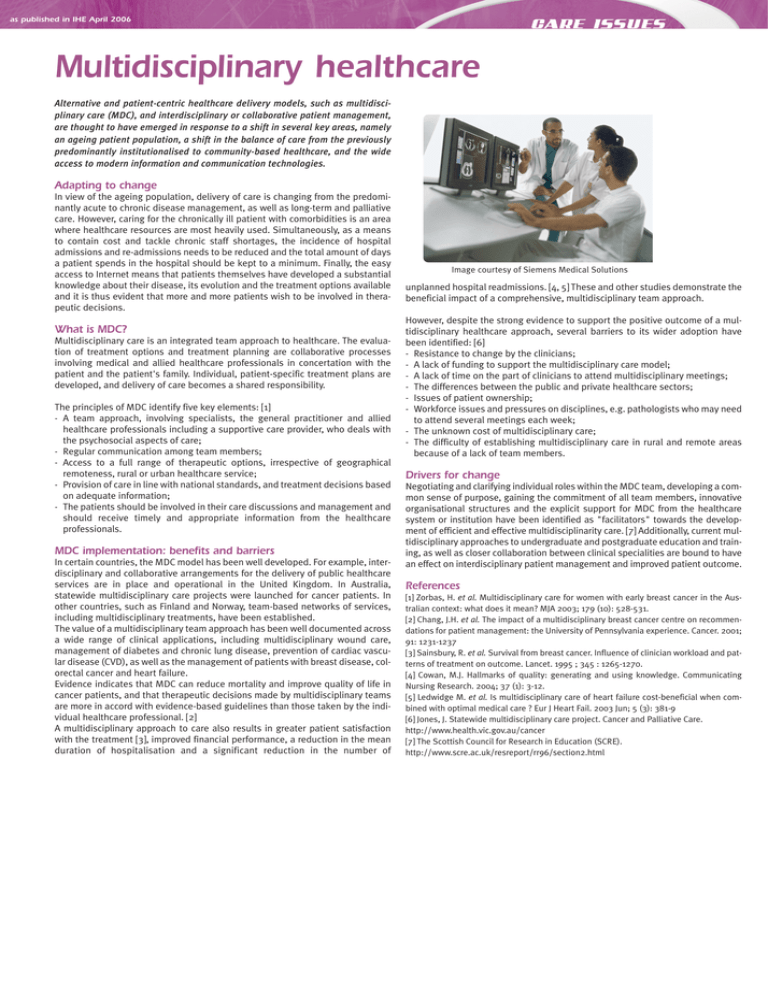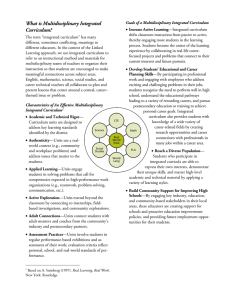Multidisciplinary healthcare
advertisement

as published in IHE April 2006 CARE ISSUES Multidisciplinary healthcare Alternative and patient-centric healthcare delivery models, such as multidisciplinary care (MDC), and interdisciplinary or collaborative patient management, are thought to have emerged in response to a shift in several key areas, namely an ageing patient population, a shift in the balance of care from the previously predominantly institutionalised to community-based healthcare, and the wide access to modern information and communication technologies. Adapting to change In view of the ageing population, delivery of care is changing from the predominantly acute to chronic disease management, as well as long-term and palliative care. However, caring for the chronically ill patient with comorbidities is an area where healthcare resources are most heavily used. Simultaneously, as a means to contain cost and tackle chronic staff shortages, the incidence of hospital admissions and re-admissions needs to be reduced and the total amount of days a patient spends in the hospital should be kept to a minimum. Finally, the easy access to Internet means that patients themselves have developed a substantial knowledge about their disease, its evolution and the treatment options available and it is thus evident that more and more patients wish to be involved in therapeutic decisions. What is MDC? Multidisciplinary care is an integrated team approach to healthcare. The evaluation of treatment options and treatment planning are collaborative processes involving medical and allied healthcare professionals in concertation with the patient and the patient's family. Individual, patient-specific treatment plans are developed, and delivery of care becomes a shared responsibility. The principles of MDC identify five key elements: [1] - A team approach, involving specialists, the general practitioner and allied healthcare professionals including a supportive care provider, who deals with the psychosocial aspects of care; - Regular communication among team members; - Access to a full range of therapeutic options, irrespective of geographical remoteness, rural or urban healthcare service; - Provision of care in line with national standards, and treatment decisions based on adequate information; - The patients should be involved in their care discussions and management and should receive timely and appropriate information from the healthcare professionals. MDC implementation: benefits and barriers In certain countries, the MDC model has been well developed. For example, interdisciplinary and collaborative arrangements for the delivery of public healthcare services are in place and operational in the United Kingdom. In Australia, statewide multidisciplinary care projects were launched for cancer patients. In other countries, such as Finland and Norway, team-based networks of services, including multidisciplinary treatments, have been established. The value of a multidisciplinary team approach has been well documented across a wide range of clinical applications, including multidisciplinary wound care, management of diabetes and chronic lung disease, prevention of cardiac vascular disease (CVD), as well as the management of patients with breast disease, colorectal cancer and heart failure. Evidence indicates that MDC can reduce mortality and improve quality of life in cancer patients, and that therapeutic decisions made by multidisciplinary teams are more in accord with evidence-based guidelines than those taken by the individual healthcare professional. [2] A multidisciplinary approach to care also results in greater patient satisfaction with the treatment [3], improved financial performance, a reduction in the mean duration of hospitalisation and a significant reduction in the number of Image courtesy of Siemens Medical Solutions unplanned hospital readmissions. [4, 5] These and other studies demonstrate the beneficial impact of a comprehensive, multidisciplinary team approach. However, despite the strong evidence to support the positive outcome of a multidisciplinary healthcare approach, several barriers to its wider adoption have been identified: [6] - Resistance to change by the clinicians; - A lack of funding to support the multidisciplinary care model; - A lack of time on the part of clinicians to attend multidisciplinary meetings; - The differences between the public and private healthcare sectors; - Issues of patient ownership; - Workforce issues and pressures on disciplines, e.g. pathologists who may need to attend several meetings each week; - The unknown cost of multidisciplinary care; - The difficulty of establishing multidisciplinary care in rural and remote areas because of a lack of team members. Drivers for change Negotiating and clarifying individual roles within the MDC team, developing a common sense of purpose, gaining the commitment of all team members, innovative organisational structures and the explicit support for MDC from the healthcare system or institution have been identified as "facilitators" towards the development of efficient and effective multidisciplinarity care. [7] Additionally, current multidisciplinary approaches to undergraduate and postgraduate education and training, as well as closer collaboration between clinical specialities are bound to have an effect on interdisciplinary patient management and improved patient outcome. References [1] Zorbas, H. et al. Multidisciplinary care for women with early breast cancer in the Australian context: what does it mean? MJA 2003; 179 (10): 528-531. [2] Chang, J.H. et al. The impact of a multidisciplinary breast cancer centre on recommendations for patient management: the University of Pennsylvania experience. Cancer. 2001; 91: 1231-1237 [3] Sainsbury, R. et al. Survival from breast cancer. Influence of clinician workload and patterns of treatment on outcome. Lancet. 1995 ; 345 : 1265-1270. [4] Cowan, M.J. Hallmarks of quality: generating and using knowledge. Communicating Nursing Research. 2004; 37 (1): 3-12. [5] Ledwidge M. et al. Is multidisciplinary care of heart failure cost-beneficial when combined with optimal medical care ? Eur J Heart Fail. 2003 Jun; 5 (3): 381-9 [6] Jones, J. Statewide multidisciplinary care project. Cancer and Palliative Care. http://www.health.vic.gov.au/cancer [7] The Scottish Council for Research in Education (SCRE). http://www.scre.ac.uk/resreport/rr96/section2.html

